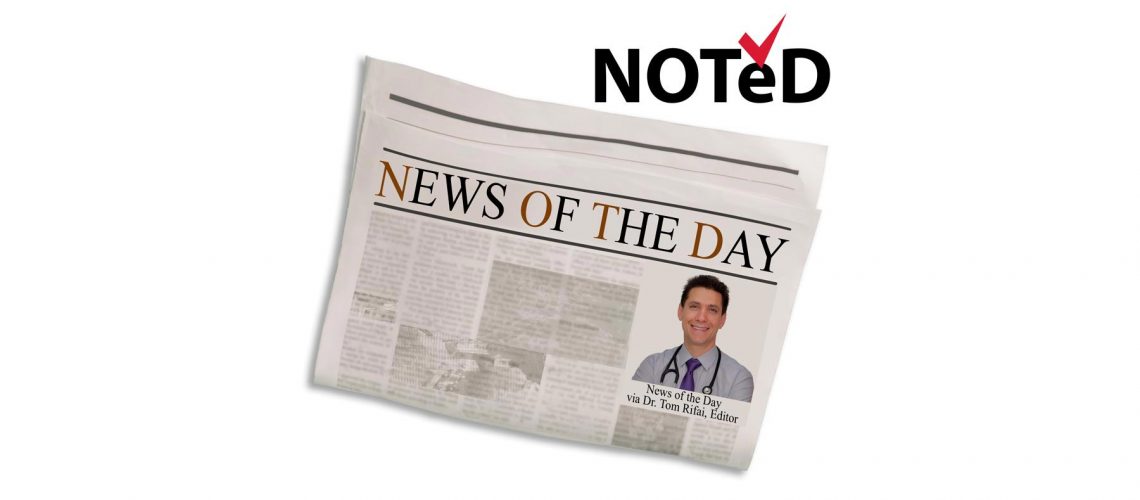Home » NOTeD: Is a Huge Breakfast Better for Weight Loss?
NOTeD: Is a Huge Breakfast Better for Weight Loss?

IN THIS WEEK’S MEDICAL NEWS:
Study: Big Breakfast Better for Weight Loss shows that “INTERMITTENT FASTING IS DEAD! A fatty, salty, gut busting big breakfast is best for weight loss and will almost triple your metabolism!”
DID THE STUDY REALLY SHOW A HUGE BREAKFAST IS BETTER FOR WEIGHT LOSS?
Sorry, no. It showed us something a little (ok, A LOT) less “sexy:” That over 3 days, 16 people with optimal weight and in their early 20s placed in necessarily unrealistic, ultra-highly controlled conditions had higher overall blood sugar, insulin and appetite (including cravings for sweets) measures with tiny breakfasts comprised of only 11% of their prescribed daily food/calorie intake, versus those that ate 69% of their prescribed calorie intake at breakfast. They also burned more calories digesting calories eaten at breakfast vs calories eaten at dinner. Based on this well designed, but exceedingly small and short (3 day) study of non-overweight, very young adults, the study’s authors broadly conclude that timing of food intake “is important…for weight loss” and the lead author (Richter) stated on behalf of the study’s investigators in a media interview: “we recommend that patients with obesity as well as healthy people eat a large breakfast rather than a large dinner to reduce body weight and prevent metabolic diseases.”
These rather sweeping recommendations for an entirety of humanity is notable in light of the fact that it was based on 16 very young subjects who did not need to lose weight and that, in fact, weight changes (nor body composition analyses which were also measured) were not even reported in the study. Great, broad and sweeping conclusions require great, broad and sweeping data. We don’t have that connection here.
It cannot go without mention how the media, even the medical media, leveraged picture choices with reckless abandon to represent their sensationalist headlines covering this small study. Pictures used could have honestly been described, as the Center for Science in the Public interest often does, as “food porn.” I read two press articles on the study in question. One was for medical practitioners, and the other was in the lay press. Links to their respective photo editors’ choices to represent the study’s breakfasts are here, from this Medpage article and here, from this Daily Mail article. Based on my reasonable estimate, the two breakfasts pictured range from 2500 (breakfast in the skillet) to 4100 mg of sodium (breakfast on the table) and a remarkable paucity of fiber. This is not to mention widely varying calorie representations from 800 to 2000. The saying goes “a picture speaks a thousand words.” But I am sad to say that these pictures spoke words that will only promise to further confuse the public in terms of critically important nutrition messaging so sorely needed. Particularly I’m referring to the incontrovertible fact that the healthiest eating patterns noted among all proven societies with healthy longevity (e.g., Blue Zones) tend to be minimally processed and plant predominant. Large breakfasts of such healthy characteristics could’ve easily been pictured, or at least ones that actually reflected the study’s prescribed breakfasts (which are still unbeknownst to me as they were not well described in the paper, ironically). I have emailed the authors of the study and await further insights on the specific foods prescribed – which are of no minor import, if they are willing and able to offer them.
EDITOR’S COMMENT
While the study authors are to be commended for executing such a highly controlled, but very small and short study, as well as providing some additional data and insight into the effects of food timing in non-overweight young adults in experimental conditions, very little can be derived from this “Big Breakfast Better for Weight Loss” study in terms of real-world recommendations. It simply adds a justifiably tiny amount of added insight into a large body of evidence that would still ultimately conclude that one should not ignore their sense of hunger nor their sense of satiety. Then we can simply focus on what – not when (other than time determined by hungry/satiety) we eat. Upshot: “eat when mild to moderately hungry and stop when comfortably full”. Notably, this is largely similar to Blue Zone Okinawans who repeat a mantra prior to eating, “hara hachi bu”, which essentially translates into “eat until you’re (only) 80% full”. If we do so and base it on an eating pattern that is largely comprised of minimally processed, plant predominant food choices with limited beverage calories, the when we eat and our health will fall into place naturally. Yes my friends, it is after, as well as it was before, this breakfast study that things are still far more along the lines of Michael Pollan’s imploring of us to “eat (real) food, mostly plants, not too much.”
BOTTOM LINE
Guided by over 20,000 hours of clinical nutrition experience in real world settings driving my perspective, I feel this study adds very little actionable information for us “average people” living in the “real world”, with all due respect to the authors’ (over) confidence in the translatability of their findings. And the pictures? That they were so egregiously inappropriate is ominous testimony to how far we have to go to see any semblance of turning around 600,000 heart attacks per year and over 120 million people with type 2 diabetes and prediabetes combined (with ~90% of prediabetics and ~25% type 2 diabetics totally oblivious to their condition, no less). Ignorance is not bliss and there’s no quick fix here. So sure, I’m all for having breakfast – if you’re hungry. And please don’t forget, irrespective of the meal, to stop when comfortably full. Eating healthily is hard enough in our CRAP (calorie rich and processed) food and beverage saturated environments and culture. Let’s not make it complicated as well.

